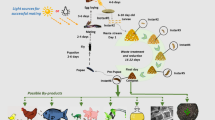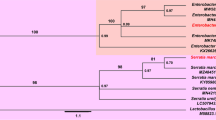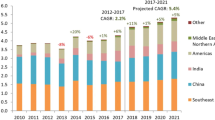Abstract
One isolate of predator fungi Duddingtonia flagrans (AC001) was assessed in vitro regarding the capacity of supporting the passage through pigs' gastrointestinal tract without loss of the ability of preying infective larvae Oesophagostomum spp. Fungal isolates survived the passage and were efficient in preying L3 since the first 8 h of collection (p < 0.01) in relation to the control group (without fungus). Compared with control, there was a significant decrease (p < 0.01) of 59.6% (8 h), 71.7% (12 h), 76.8% (24 h), 81.0% (36 h), 78.0% (48 h), 76.1% (72 h), and 82.7% (96 h) in means of infective larvae Oesophagostomum spp. recovered from treatments with isolate AC001. Linear regression coefficients of L3 of recovered Oesophagostomum spp. regarding the collections due to time were −0.621 for control, −1.40 for AC001, and −2.64 for NF34. Fungi D. flagrans (AC001) had demonstrated to be promising for use in the biological control of pig parasite Oesophagostomum spp.

Similar content being viewed by others
References
Araujo, J.M., Araújo, J.V., Braga, F.R. and Carvalho, R.O., 2010. In vitro predatory activity of nematophagous fungi and after passing through gastrointestinal tract of equine on infective larvae of Strongyloides westeri. Parasitology Research, 107, 103–107
Araújo, J.V., Santos, M.A., Ferraz, S. and Maia, A.S., 1993. Antagonistic effect of predacious fungi Arthrobotrys on infective Haemonchus placei larvae. Journal. Helmintholohy, 67, 136–138
Araújo, J.V., Assis, R.C.L., Campos, A.K. and Mota, M.A., 2006. Efeito antagônico de fungos predadores dos gêneros Monacrosporium, Arthrobotrys e Duddingtonia sobre larvas infectantes de Cooperia sp. e Oesophagostomum sp.. Arquivo Brasileiro de Medicina Veterinária e Zootecnia, 58, 373–380
Araújo, J.V., Braga, F.R., Araújo, J.M., Silva, A.R. and Tavela A.O., 2008. In vitro evaluation of the effect of the nematophagous fungi Duddingtonia flagrans, Monacrosporium sinense and Pochonia chlamydosporia on Ascaris suum eggs. Parasitology Research, 102, 787–790
Ayres, M., Ayres, J.R.M., Ayres, D.L. and Santos, A.S., 2003. Aplicações estatísticas nas áreas de ciências biológicas. Brasília
Blair, R. 2007. Nutrition and Feeding of Organic Pigs. Cromwell Press, Trowbridge.
Boes, J., Willingham A.L., Fuhui, S., Hu Xuguang, H., Eriksen, L., Nansen, P. and Stewart T.B., 2000. Prevalence and distribution of pig helminths in the Dongting Lake Region (Hunan Province) of the People’s Republic of China. Journal of Helminthology, 74, 45–52
Braga, F.R., Araújo, J.V., Silva, A.R., Araujo, J.M., Carvalho, R.O., Tavela, A.O., Campos, A.K. and Carvalho, G.R., 2009. Biological control of horse cyathostomin (Nematoda: Cyathostominae) using the nematophagous fungus Duddingtonia flagrans in tropical southeastern Brazil. Veterinary Parasitology, 163, 335–340
Braga, F.R., Araújo, J.V., Araújo, J.M., Silva, A.R., Carvalho, R.O., Ferreira, S.R. and Benjamin, L.A., 2010. Predatory activity of the nematophagous fungus Duddingtonia flagrans on horse cyathostomin infective larvae. Tropical Animal Health and Production, 42, 1161–1163
Campos, A.K., Araújo, J.V., Guimarães, M.P., Dias, A.S., 2009. Resistance of different fungal structures of Duddingtonia flagrans to the digestive processes and predatory ability on larvae of Haemonchus contortus and Strongyloides papillosus in goat feces. Parasitology Research, 105, 913–919
Carvalho, R.O., Araújo, J.V., Braga, F.R., Araújo, J.M., Silva, A.R. and Tavela, A.O., 2009. Predatory activity of nematophagous fungi on Ancylostoma ssp. infective larvae: evaluation in vitro and after passing through gastrointestinal tract of dogs. Journal of Helminthology, 83, 231–239
Haugegaard, J., 2010. Prevalence of nematodes in Danish industrialized sow farms with loose housed sows in dynamic groups. Veterinary Parasitology, 168, 156–159
Lai, M., Zhou, R.Q., Huang, H.C. and Hu, S.J., 2011. Prevalence and risk factors associated with intestinal parasites in pigs in Chongqing, China. Research in Veterinary Science (in press)
Larsen, M., 1999. Biological control of helminthes. International Journal for Parasitology, 29, 139–146
Lin, R.Q., Ai, L., Zou, F.C., Verweij, J.J., Jiang, Q., Li, M.W., Song, H.Q. and Zhu, X.Q., 2008. A multiplex PCR tool for the specific identification of Oesophagostomum spp. from pigs..Parasitology Research, 103, 993–997
Mota, M.A., Campos, A.K. and Araújo, J.V., 2003. Controle biológico de helmintos parasitos de animais: estágio atual e perspectivas futuras. Pesquisa Veterinária Brasileira, 23, 93–100.
Nansen, P., Foldager, J., Hansen, J., Henriksen, S.A. and Jorgensen, R.J., 1988. Grasing pressure and acquisition of Ostertagia ostertagi in calves. Veterinary Parasitology, 27, 325–335
Nansen, P., Larsen, M., Roepstorff, A., Grønvold, J., Wolstrup, J. and Henriksen, S. A., 1996. Control of Oesophagostomum dentatum and Hyostrongylus rubidus in outdoor-reared pigs by daily feeding with the microfungus Duddingtonia flagrans. Parasitology Research, 82, 580–584
Petkevicius, S., Larsen, M., Bach Knudsen, E. K., Nansen, P., Gronvolda, J., Henriksen, S. A. A. and Wolstrup, J., 1998. The effect of the nematode-destroying fungus Duddingtonia flagrans against Oesophagostomum dentatum larvae in faeces from pigs fed different diets. Helminthologia, 35, 111 – 116
Sagüés, M.F., Fusé, L.A., Fernández, A.S., Iglesias L.E., Moreno F.C. and. Saumell C.A., 2011. Efficacy of an energy block containing Duddingtonia flagrans in the control of gastrointestinal nematodes of sheep. Parasitology Research (in press)
Santurio, J.M., Zanette, R.A., Da Silva, A.S., Fanfa, V.R., Farret, M.H., Ragagnin, L., Hecktheuer, P.A. and Monteiro, S.G., 2011. A suitable model for the utilization of Duddingtonia flagrans fungus in small-flock-size sheep farms. Experimental Parasitology, 127, 727–31
Sanyal, P.K., 2001. Control of tropical fasciolosis in cattle and buffaloes in India at the backdrop of its integrated management. Journal of Veterinary Parasitology, 15, 13–16.
Scholler, M. and Rubner, A., 1994. Predacious activity of the nematode destroying fungus Arthrobotrys oligospora in dependence of the medium composition. Microbiology Research, 149, 145–149
Singh, R.K., Sanyal P.K., Patel N.K., Sarkar A.K., Santra A.K., Pal1, S. and Mandal S.C., 2010. Fungus–benzimidazole interactions: a prerequisite to deploying egg-parasitic fungi Paecilomyces lilacinus and Verticillium chlamydosporium as biocontrol agents against fascioliasis and amphistomiasis in ruminant livestock. Journal of Helminthology, 84, 123–131
Terril, T.H., Larsen, M., Samples, O., Husted, S., Miller, J.E., Kaplan, R.M. and Gelaye, S., 2004. Capability of the nematode-trapping fungus Duddingtonia flagrans to reduce infective larvae of gastrointestinal nematodes in goat feces in the southeastern United States: dose titration and dose time interval studies. Veterinary Parasitology, 120, 285–296
Ueno, H. and Gonçalves, P.C., 1998. Manual para diagnóstico das helmintoses de ruminantes, (Japan International Cooperation Agency, Tókio)
Van Oorschot, C.A.N., 1985. Taxonomy of the Dactylaria complex. A review of Arthrobotrys and allied genera. Studies in Mycology, 26, 63–91
Waller, P.J., Larsen, M., Faedo, M. and Hennessy, D.R., 1994. The potential of nematophagous fungi to control the free living stages of nematode parasites of sheep: in vitro and in vivo studies. Veterinary Parasitology, 51, 289–299
Acknowledgments
The authors would like to thank CNPq and Capes for the financial support.
Author information
Authors and Affiliations
Corresponding author
Additional information
Jackson Victor de Araújo received a scholarship from CNPq.
Rights and permissions
About this article
Cite this article
Ferreira, S.R., de Araújo, J.V., Braga, F.R. et al. In vitro predatory activity of nematophagous fungi Duddingtonia flagrans on infective larvae of Oesophagostomum spp. after passing through gastrointestinal tract of pigs. Trop Anim Health Prod 43, 1589–1593 (2011). https://doi.org/10.1007/s11250-011-9848-7
Accepted:
Published:
Issue Date:
DOI: https://doi.org/10.1007/s11250-011-9848-7




